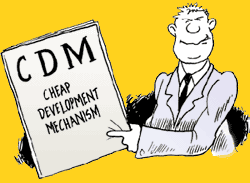
|
 |
 |
| |
|
 Two jeers Two jeersfor democracy The purpose of the clean development mechanism shall be to assist Parties not included in Annex I in achieving sustainable development and in contributing to the ultimate objective of the Convention, and to assist Parties included in Annex I in achieving compliance.... — Article 12.2, Kyoto Protocol Article 12 is a dream. The verbal montage — ‘assist’ (twice), ‘achieving’, ‘contributing’ ‘ultimate’ — is manifestly about environmental integrity. Yet the seamless metonymy must be beguiling. Dreams have a latent purpose, too. Exactly what could article 12 mean, by not meaning to? What metaphor will point to the royal road of multilateral cooperation? CDM. Let’s talk transaction fees. A reasonable estimate of the amount required for a single project pegs the figure at US $150,000. A developing country entity mitigates climate change and cough this up, from start to finish (Project Design Document to when it gets Certified Emission Reductions, CERs). The World Bank’s Prototype Carbon Fund and the Dutch CERUPT programme offer some subsidies in the documentation stage, but this is not the rule. This safely rules out small-scale projects geared towards poor communities in the rural areas of developing countries. They are the ones who need development funds. At this point, it is wise to digress. Exactly how is this money spent? You know it. It is paid to consultants and operational entities, the ones who get the work and the paperwork done. Think of a party interested in a CDM project (an anybody or a government; out of idealism or wads). It soon turns into a search for sustainability criteria and technological priorities. An endorsement procedure leads them to their government. So comes into existence that technical term: ‘host’ (and its Other, ‘parasite’.) The host country can favour or deny particular sectors of the society. It is free to impose priorities and endorsement rules. Take India, a large developing country that stands to get a fair share of the CDM funds on offer, perhaps too fair a share. It’s still evolving criteria; is probably keen on very flexible guidelines because it doesn’t want to scare away investors with complex procedures. Question is: who stands to gain? Again, you know. Industry. Gurmit Singh of Malaysia, who is with the Climate Action Network-Southeast Asia, says the entire CDM process ensures what the North gives from one hand it takes back from the other. Namely, fees that very often go to consultants from the North. He cites the example of a project to trap methane gas from palm oil oxidation plants and convert it into energy. The technology is already around in Malaysia, he explains. So the project translates into the money a company gets to actually implement it — there is no real technology transfer. Just a loan over and above a normal commercial loan — that, too, only for the incremental cost of the device to trap the gas and to burn it to generate power, not the entire plant. CDM also fails on principles of international democracy and equity. The losers in the international wrangle are likely to be poorer countries. A solution is what is called bundling of projects. A number of projects across a region of a country or several countries are bundled together to share the transaction costs. But if one or two small projects fall off, the other projects are left with high transaction costs. Besides, bundling projects is compared to bundling different kinds of people together. It is very likely that industry in large developing countries stand to gain the most out of CDM, and the poorest communities in the poorest countries stand to gain nothing. There is virtually no understanding of what CDM means at the community level in developing countries. Isn’t Article 12 a dream?
|
|
|||
|
Copyright © CSE Centre for Science and Environment